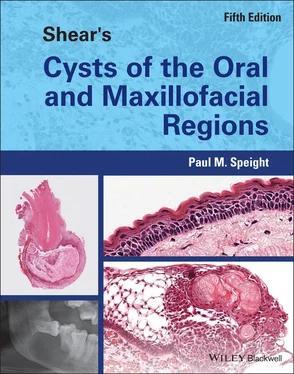Paul M. Speight - Shear's Cysts of the Oral and Maxillofacial Regions
Здесь есть возможность читать онлайн «Paul M. Speight - Shear's Cysts of the Oral and Maxillofacial Regions» — ознакомительный отрывок электронной книги совершенно бесплатно, а после прочтения отрывка купить полную версию. В некоторых случаях можно слушать аудио, скачать через торрент в формате fb2 и присутствует краткое содержание. Жанр: unrecognised, на английском языке. Описание произведения, (предисловие) а так же отзывы посетителей доступны на портале библиотеки ЛибКат.
- Название:Shear's Cysts of the Oral and Maxillofacial Regions
- Автор:
- Жанр:
- Год:неизвестен
- ISBN:нет данных
- Рейтинг книги:5 / 5. Голосов: 1
-
Избранное:Добавить в избранное
- Отзывы:
-
Ваша оценка:
- 100
- 1
- 2
- 3
- 4
- 5
Shear's Cysts of the Oral and Maxillofacial Regions: краткое содержание, описание и аннотация
Предлагаем к чтению аннотацию, описание, краткое содержание или предисловие (зависит от того, что написал сам автор книги «Shear's Cysts of the Oral and Maxillofacial Regions»). Если вы не нашли необходимую информацию о книге — напишите в комментариях, мы постараемся отыскать её.
Shear’s Cysts of the Oral and Maxillofacial Regions
Shear’s Cysts of the Oral and Maxillofacial Regions Fifth Edition
Shear's Cysts of the Oral and Maxillofacial Regions — читать онлайн ознакомительный отрывок
Ниже представлен текст книги, разбитый по страницам. Система сохранения места последней прочитанной страницы, позволяет с удобством читать онлайн бесплатно книгу «Shear's Cysts of the Oral and Maxillofacial Regions», без необходимости каждый раз заново искать на чём Вы остановились. Поставьте закладку, и сможете в любой момент перейти на страницу, на которой закончили чтение.
Интервал:
Закладка:
Cysts of the Major and Minor Salivary Glands
1 MucocelesMucous extravasation cystMucous retention cystRanula
2 Salivary duct cyst (of the major glands)
3 Intraoral lymphoepithelial cyst
4 Lymphoepithelial cysts of the parotid gland
5 Polycystic disease of the parotid gland
Cysts of the Maxillary Sinus
1 Mucoceles
2 Retention cyst
3 Pseudocysts
Developmental Cysts of the Head and Neck
These cysts are mostly congenital and are usually present at birth, although some may grow slowly and not become clinically apparent until later in childhood or adolescence. The majority arise from epithelial remnants entrapped during fusion of the facial processes or due to incomplete obliteration of the branchial clefts or pouches.
1 Dermoid and epidermoid cysts
2 Cysts of foregut originHeterotopic gastrointestinal cystBronchogenic cyst
3 Branchial cleft cysts
4 Thyroglossal duct cyst
5 Nasopharyngeal cyst
6 Thymic cyst
Frequency of Cysts of the Oral and Maxillofacial Regions
Frequency statistics differ from incidence studies in that they are not standardised against known population data, such as age, sex, and ethnicity. For data to be comparable between populations and internationally, age‐standardised incidence rates per 100 000 are compared with a standard world population. Incidence data are a requirement for all national cancer registries, but most benign lesions, including cysts, are not registered and thus incidence data is not available for the odontogenic cysts. Epidemiological data are therefore presented as the relative frequency of each cyst type as a proportion of the total number of cysts encountered within a population, or of the total number of specimens received. This gives clinicians an estimate of the likelihood of encountering these lesions in everyday practice.
Frequency studies are rarely based on the general population, but are usually derived from archival records of diagnoses made in a hospital department, usually pathology departments. While these provide useful data on the behaviour and treatment of different diseases, they are of limited use in international comparative studies. Table 1.3shows the wide variation in the frequency of the three most common odontogenic cysts in different parts of the world. Almost without exception, these data are derived from retrospective analyses of pathology records and the frequency of each cyst type may depend on local protocols for patient referral and management, or even on individual pathologists' criteria for diagnosis. For example, a high frequency of radicular cysts may reflect a high caries rate in the local population, or a high rate of referral of periapical lesions. Conversely, a low frequency of radicular cysts may arise if the local practice is not to submit periapical lesions for histological analysis. In Chapter 4we discuss the very low frequency of paradental cysts in some countries, where the lesion does not seem to be recognised as an entity and is therefore not diagnosed.
Tables 1.1and 1.2present our experience of the frequencies of jaw cysts in South Africa and the United Kingdom. Although the actual frequencies vary, the relative frequencies and the rank order of the lesions are very similar. In these studies, and in all studies worldwide ( Table 1.3), the most common odontogenic cyst is the radicular cyst, followed by dentigerous cyst and then odontogenic keratocyst. The nasopalatine duct cyst is the most common non‐odontogenic cyst and in some studies has a similar frequency among all jaw cysts to the odontogenic keratocyst ( Table 1.1). All the other cyst types are relatively rare.
These data show the relative frequency of each cyst as a proportion of all cyst types, but do not allow a clinician to determine how likely it is that they will encounter a cyst in everyday practice. Jones and Franklin (2006a ) reviewed over 44 000 histologically diagnosed oral and maxillofacial lesions in adults over a 30‐year period. Their data show that all the cyst types described in this book represent about 20% of all biopsies received (n = 8354). Odontogenic cysts were by far the most commonly encountered (n = 6052) and the overall most common cyst type in the maxillofacial regions was the radicular cyst. They found 3793 radicular cysts (including residual cyst), representing 8.6% of all biopsy specimens received. Dentigerous cysts represented 2.5% (n = 1081) of all biopsies, and odontogenic keratocyst was 1.3% (n = 591). By comparing these data to other commonly encountered lesions, a clinician can estimate the likelihood of encountering a cyst. Common diagnoses included 6458 cases of fibrous hyperplasia (14.7%), 2973 cases of lichen planus (6.8%), and 1901 epulides (4.3%; fibrous epulis, pyogenic granuloma, or giant cell epulis). During the same period, there were 3547 periapical granulomas, showing that the frequency of periapical granulomas (8.1%) and radicular cysts (8.6%) is similar. This was also suggested by Koivisto et al. (2012 ), who reviewed 9723 radiolucent lesions associated with the teeth (dentigerous cysts and lesions in the ramus were excluded) and found that 73% were periapical granulomas or cysts. There were 3215 (33.1%) radicular cysts and 3931 (40.4%) periapical granulomas. The next most common lesion was the odontogenic keratocyst (8.8%; n = 857).
Table 1.1 Distribution of 3481 jaw cysts according to diagnosis.
Source: Data courtesy of Prof. M. Shear, University of Witwatersrand.
| n | % of group | % of all cysts | |
|---|---|---|---|
| Odontogenic cysts | |||
| Radicular/residual cyst | 1825 | 60.6 | 52.4 |
| Dentigerous cyst | 599 | 19.9 | 17.2 |
| Eruption cyst | 27 | 0.9 | 0.8 |
| Odontogenic keratocyst (including orthokeratinised odontogenic cysts) | 355 | 11.8 | 10.2 |
| Inflammatory collateral cysts | 109 | 3.6 | 3.1 |
| Calcifying odontogenic cyst | 28 | 0.9 | 0.8 |
| Lateral periodontal cyst | 24 | 0.8 | 0.7 |
| Gingival cyst of adults | 21 | 0.7 | 0.6 |
| Unclassified | 18 | 0.6 | 0.5 |
| Glandular odontogenic cyst | 6 | 0.2 | 0.2 |
| 3012 | 100.0 | ||
| Non‐odontogenic cysts | |||
| Nasopalatine duct cyst | 404 | 86.1 | 11.6 |
| Simple bone cyst | 35 | 7.5 | 1.0 |
| Nasolabial cyst | 21 | 4.5 | 0.6 |
| Surgical ciliated cyst | 5 | 1.1 | 0.1 |
| Mucosal cyst of maxillary antrum | 4 | 0.9 | 0.1 |
| 469 | 100.0 | ||
| Total | 3481 | 100.0 |
Table 1.2 Distribution of 7121 odontogenic cysts in a United Kingdom population.
Source: Data from Jones et al. (2006 ).
| Cysts | n | % |
|---|---|---|
| Radicular cyst | 3724 | 52.3 |
| Residual cyst | 573 | 8.0 |
| Dentigerous cyst | 1292 | 18.1 |
| Eruption cyst | 15 | 0.2 |
| Odontogenic keratocyst (including orthokeratinised odontogenic cysts) | 828 | 11.6 |
| Inflammatory collateral cysts | 402 | 5.6 |
| Unclassified odontogenic cysts | 210 | 2.9 |
| Lateral periodontal cyst | 28 | 0.4 |
| Calcifying odontogenic cyst | 21 | 0.3 |
| Gingival cyst of adults | 16 | 0.2 |
| Glandular odontogenic cyst | 11 | 0.2 |
| Gingival cyst of infants | 1 | 0.0 |
| Total | 7121 | 100.00 |
Table 1.3 Frequency (%) of the three most common odontogenic cysts in selected case series with a wide geographical distribution.
Читать дальшеИнтервал:
Закладка:
Похожие книги на «Shear's Cysts of the Oral and Maxillofacial Regions»
Представляем Вашему вниманию похожие книги на «Shear's Cysts of the Oral and Maxillofacial Regions» списком для выбора. Мы отобрали схожую по названию и смыслу литературу в надежде предоставить читателям больше вариантов отыскать новые, интересные, ещё непрочитанные произведения.
Обсуждение, отзывы о книге «Shear's Cysts of the Oral and Maxillofacial Regions» и просто собственные мнения читателей. Оставьте ваши комментарии, напишите, что Вы думаете о произведении, его смысле или главных героях. Укажите что конкретно понравилось, а что нет, и почему Вы так считаете.












